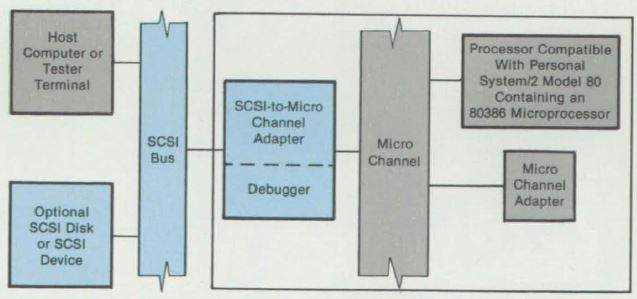|
Author: Lyndon B. Johnson Space Center, Houston, Texas
Source: NASA Tech Briefs, Dec 1990 (page 27 physical)
The Small Computer System Interface (SCSI) communication test bus provides a
high-data-rate, standard interconnection that enables communication among an
International Business Machines (IBM) Personal System/2 Micro Channel, other
devices connected to the Micro Channel, test equipment, and a host computer.
Previously, slower and less-intelligent interface buses have been used for
testing: these include the IEEE-488 [general-purpose interface bus (GPIB)], the
RS-232, and the RS-422. The SCSI communication test bus is implemented by use
of the SCSI bus (see figure), which, heretofore, has been used primarily
commercially as a communication channel between a host computer and a direct
access storage device.

The SCSI Communication Test Bus serves primarily as a
non-intrusive input/output attachment to the PS/2 Micro Channel bus, providing
rapid communication for the debugger
One requirement that motivated this application of the SCSI is the need for
a "debugger" that can monitor activities on the Micro Channel non-intrusively.
The debugger must also enable test equipment to communicate with an 80386
microprocessor on the Micro Channel. The debugger operates in two modes:
nonintrusive and interfacing. In the non intrusive mode, the debugger behaves
as a passive monitoring device that does not affect any activities on the Micro
Channel. In the interfacing mode, it enables test equipment to communicate with
the 80386 microprocessor through the Micro Channel. The debugger also enables
the host computer to read from, and write to, the memory or input/output ports
of the Micro Channel. This interfacing mode is also known as the "bus master"
mode of the Micro Channel.
The data-transfer rate of the SCSI - 4 MB/s - meets the
high-speed-communication requirement for the debugger, and upgrades to higher
speeds are under consideration. The maximum attainable speeds of previous test
buses (e.g., 1 MB/s in the IEEE-488) were insufficient for sending data back to
host computers while continuously acquiring more data. Usually, to hold large
traces of collected test data, previous debuggers included large and costly
high speed memories. The collected data were transferred back to the host
computer only after the traces had been stopped. The data could be used for
monitoring only; real-time processing and other actions were not possible.
With the high speed of the SCSI bus and the intelligence of the SCSI
controller, data from the debugger can be sent back to the controlling host
computer continuously while the debugger collects more data from the Micro
Channel. The number of data that can be collected by the debugger is limited
only by the storage capacity of the controlling host computer. This opens up
the possibility of using the debugger in real-time applications that were
impossible with older test buses.
This work was done by Chanh V. Hua,
John J D 'Ambrose, Richard C. Jaworski,
Elaine M. Halula, David N. Thornton, Robert
L Heligman, and Michael R. Turner of International
Business Machines Corp. for
Johnson Space Center. For further information,
Circle 17 on the TSP Request Card.
MSC-21704
|